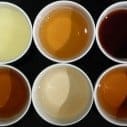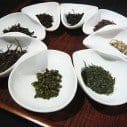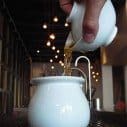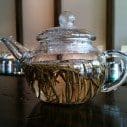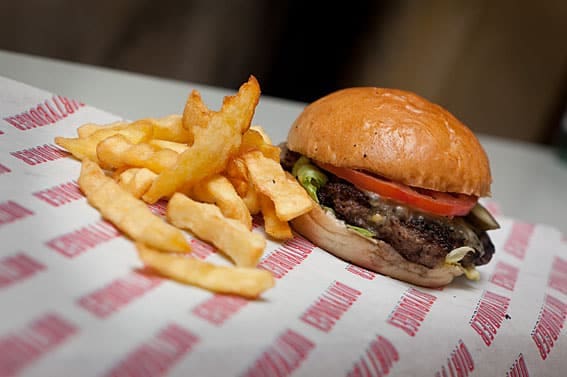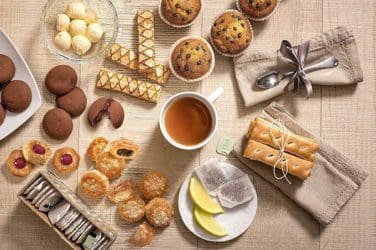I suppose I ought to begin this piece with a confession: I don’t like tea. Whilst I understand that this is as un-British as admitting an inability to queue properly, or a lack of interest in weather-related conversation, there is little I can do to convince myself that it tastes like anything other than warm, sugary ditch water.
Despite this, there remains something inherently patriotic about consuming cup after cup of the stuff, and I would forgive anyone who found my dislike of tea suspicious. So when I was asked to trot along to TeaSmith, founded by John Kennedy and wife Tomoko Kawase, I dutifully agreed. A cursory glance at their website told me they were collaborating with renowned patissier William Curley, so I was very much hoping I would be able to sip at my cup politely, whilst masking any unpleasant taste with some petit-fours.
Located in London’s Spitalfieds Market, this intimate café-cum-gift shop finds itself at the heart of a demographic-crossroads: city folk, tourist hordes and too-cool-for-school Shoreditchers all rub shoulders amongst vintage furniture stalls and upmarket coffee chains. The venue itself looks much as you would expect, given the Japan meets East London vibe. The décor harmonises well with the concept- Japanese tea-culture in a contemporary, design-lead venue. John had his first ‘tea-epiphany’ many years ago: when living in San Francisco and enjoying an Earl Grey, he stumbled upon a farmers market selling ‘proper tea.’ Now, in my ignorance, I thought Early Grey was ‘proper tea,’ so you can imagine my confusion. Vowing never to touch any of the household blends that we Brits consume so voraciously again, John returned to the UK several years later, pounding the streets of China Town in search of something authentic. Finding nothing, he quickly realised that the only way of getting a decent cup of tea would be to provide it himself; in November 2006, TeaSmith was born. Its aim? “To put the ceremony back into tea-drinking, and de-mystify it a bit. It can seem quite an intimidating concept at first,” John concedes. And what of the crowd? Not a yummy-mummy in sight- quite frankly, something John seems relieved about. This is clearly an establishment where the focus is on what’s in the cup, not what’s on MumsNet. Instead, TeaSmith provides a haven for informed connoisseurs and curious foodies alike.
And so, am I here to tell you I experienced my own ‘tea-epiphany’? Well, yes, actually. Because as it turns out, we Brits were doing it wrong all this time. Apparently, our tea-drinking customs are not only sacrilegious, they also fail to make a great deal of sense. We buy industrially-farmed tea leaves grown too quickly to develop any real flavour, which we then insist on stewing in oversized (if decorative) teapots. We then mask the bitterness that ensues with milk, before adding sugar to replace the sweetness we boiled out in the first place. Added to that, most of our tea is farmed in Africa, which, unlike Japan and China, is far too hot to produce anything worthwhile anyway. John explains: “It’s like you’ve been drinking wine your whole life and someone says to you- ‘Hey? Ever heard of France?’” In fact, the parallels with fine wine are numerous: just as a ’61 Bordeaux won’t taste quite the same from a plastic cup, a chipped builder’s mug does little justice to an Old Tippy Puer. Likewise, I learnt that water temperature in the brewing process should alter according to each tea, and aged teas can command as much as a vintage wine. At £15 a pot, an Aged Oolong sets you back just as much as an under-poured, over-garnished hotel bar cocktail.
I sampled several infusions of four different teas. First up, a High Mountain Oolong- the signature tea of Taiwan. A slow grown leaf, it is clean-tasting and, to me, surprisingly palatable- lucky, really, seeing as the petit-fours are yet to make an appearance. This is followed by a roasted version, Tieguanyin. Apparently roasting a tea neutralises the stimulants whilst boosting the natural sugars, resulting in an easy drinking tea suited to any hour of the day. We then move swiftly on to green tea- the Red Bull of the East. Green teas are more focused on efficacy than taste, and this one arguably lacks the smoothness of an Oolong, but within a few minutes I’ve certainly perked up. In fact, I may well have transcended perky and hit skittish territory, because at this point John asks if I’d had breakfast. I hadn’t. He hurriedly digs out a (delicious) sea salt caramel to stop me bouncing off the walls. And so finally, we move on to an Aged Tippy Puer- confidently sold to me as “the best digestive in the world.” A soothing, earthy brew that’s aged to mellow out taste, it’s probably my favourite yet- particularly since it’s served alongside a miso and walnut biscuit. The purported slimming properties of the tea probably won’t do any harm, either.
Whilst I’m perched at the bar, John explains the concept of the TeaSmith Afternoon Tea Ceremony. Admittedly, I’d never given it a great deal of thought before, but he makes a pertinent point: for a long time, the tea has taken a backseat in the whole affair, overshadowed by an array of showy cakes and sandwiches. This is something he is striving to change with his own, more tea-centric version. Not to worry though- I’m assured the petit-fours still make an appearance. For anyone really keen on swotting up on their brews, TeaSmith also offer an intimate masterclass once a month.
So there you have it. If your PG Tips just doesn’t hit the spot anymore, head on down to Spitalfields for some re-education, and a nice pot of tea- just not as you know it.
See more at www.teasmith.co.uk
words Aimee Hunt


